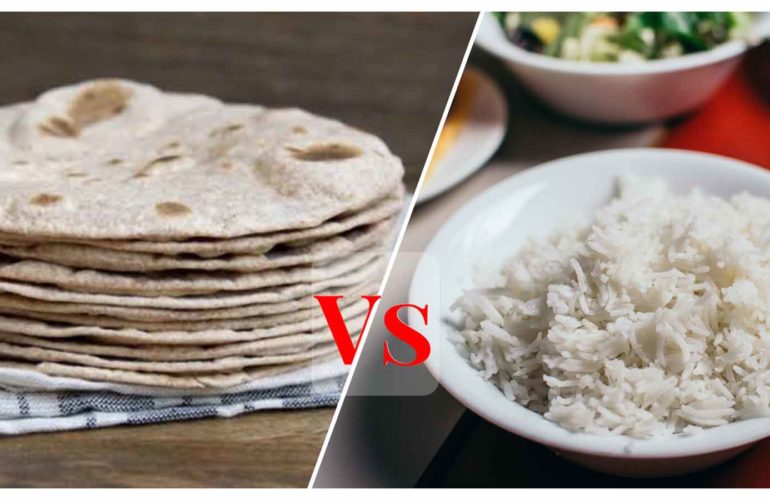Being Indians no meal for us is complete without roti or rice or both. Both roti and rice form staple elements of our diet. Of late, there’s been a lot of questions asked about the pros and cons and the nutritional value of both roti and rice. Some of us also think that both roti and rice should be avoided altogether. There are a lot of other misconceptions which are answered in this article.
1. Nutritional facts :
Let’s start with the nutritional facts of both roti and rice. Both food have similar carbs level and calorific value but different nutritional value as rotishave more protein and fibre. Let’s see the nutritional facts of both.
| Nutritional facts | One serving of roti (2 rotis) 40-45 grams | One serving of rice (1/2 cup) 40-45 grams |
| Calories | 106 | 118 |
| Carbs | 22 grams | 22.5 grams |
| Protein | 5 grams | 2.5 grams |
| Fat | 1 gram | 2 grams |
| Fibre | 5 grams | 1 gram |
Minerals :
Each serving of rotis provides you with Calcium, Phosphorus, Iron and Potassium. Whereas rice provides the same amount of Iron but lesser Phosphorus, Potassium and Magnesium. Rice also does not have Calcium.
Vitamins :
Both rice and roti provide Folate which is a water soluble Vitamin B. Rice however is a better source of Folate compared to roti.
2. Glycemic Index :
The digestion of roti is slower. Being a complex carb it keeps you full for long. Rice on the other hand is a simple carb. It gives you instant energy as the digestion is quick. However, on the downside, you start feeling hungry really soon.
Glycemic Index : The food mixes with blood to increase the insulin level. The glycemic index of rotis is low as it contains complex carbs. Rice on the other hand has a higher glycemic index as it contains simple carbs. It means that rice gives instant energy where as rotis give slow and stable energy.
This also means that rice spikes up the insulin level and roti does not.
3. How much to eat :
For a average sized person, 2 rotis i.e each around 20-22 grams and 1/2 cup rice that is around 40-45 grams is sufficient portion.
- Eating controlled portion of rice with more lentil (dal), legumes (chole, rajma), salad and curd is recommended.
- This improves the fiber content in your portion and also the protein ratio making it a healthy option for maintaining ideal weight.
4. How to control portion :
Start with serving dal, rajma, chole etc. Fill your bowl with these first. Have salad, curd and other sabzi in the side and in the end help yourselfwith a helping of some rice.
- Rice (cereals) with lentil / legumes is also a healthy combination as it gives you all nine essential amino acids making it a complete protein meal.
5. When to eat rice and roti :
There is no fixed formula to when have roti or rice. You can even include both of these together in the meal. However, you must have a balanced quantity for both.
- Having rice pre workout is advisable as it gives you instant energy. Having rice at dinner would make you feel hungry at night.
- Rotis on the other hand can be had for dinner as it takes a considerable amount of time for them to digest.
6. Stick to your family / staple food :
North Indians mostly have rotis as a staple ingredient in the diet. Abundant growth of wheat is North India is the reason for this. Coastal areas and Southern States of India on the other hand have rice as the staple ingredient.
- There is no need change the staple ingredients in your diet.
- By now your body is used to this staple food.
- Having these in the right quantity and living a healthy a healthy lifestyle is however very important.
- There are some misleading facts that rice makes you bloat or even put on weight. Most of the Southeastern nations have rice as their staple diet and people from these countries are lean and healthy.
7. Buy rice and wheat carefully :
Some points should be kept in mind before buying wheat and rice.
Wheat : It’s always better to buy good quality wheat instead of buying aata from the grocery store. That way you know the exact quality of the aata and there are less chances of adulteration.
Rice : Brown rice is more nutritious compared to white rice. White rice because it is polished loses fibre and is not healthy.
8. Some tips for eating rice to stay fit
- Control your portion size
- Eat rice with large serving of lentil / legume for protein and fibre
- Avoid eating rice in dinner
- People with diabetes should avoid eating white rice and stick to having brown rice instead
- Stuck to your staple diet
Living a healthy lifestyle is equally important. Keep yourself fit by regular exercise and including all types of food in your diet. Stay Healthy Stay Fit !!
